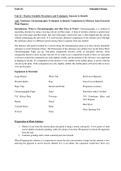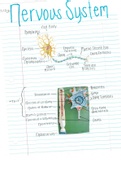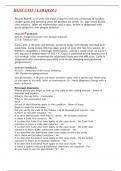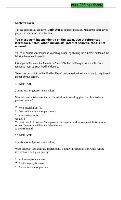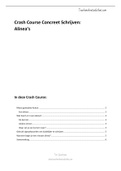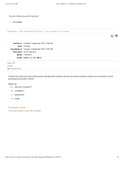SYSTEM THEORY
LECTURE 1
INTRODUCTION “ORGANIZATIONS AS SOCIAL SYSTEMS CONDUCT EXPERIMENTS”
Main theme of systems theory: regulating systems (or: dealing with complexity)
1. To explain this theme, the following issues are relevant:
- a “concrete” system can be described as: “a set of elements and relations
between them, showing particular behavior”
- the system’s behavior can be described (a) in terms activities (or transformation
processes) and (b) in terms of the effect of these activities. Describing the effect
is done in terms of “variables” (the set of variables, used to describe behavior =
“abstract system”), we are more interested in the effects of the activities, they
exist out of variables and their values and has something to do with the output
- behavior can be desired or undesired (norm value: difference between what you
want and don’t want)
- it can be said that “undesired behavior” is caused by disturbances
- in systems theory, a focus is on ‘regulating a system’s behavior’ i.e. making sure
that, in spite of all kinds of disturbances, some concrete system shows desired
behavior (regulation means thinking, regulating and performance actions)
- If one equals ‘disturbances’ with complexity , it is easy to see that regulating
relates to ‘dealing with complexity’
Regulating systems can be divided into recipe and complexity.
2. To make sure that some particular concrete system shows desired behavior, in spite of
disturbances, the following basic set of steps are relevant (recipe):
(0) Overarching goal
By taking a bath: enjoying
(1) Determine the (concrete as well as abstract) system
There are two type of systems: (1) concrete system, concrete unity in
behaviour in variables and values (above) set of elements, behaviour is having
a bath. (2) Abstract system, the set of variables that describe the behaviour.
Variables: temperature of the water, enjoying is the overarching goal that is
defined by the temperature of the water
(2) Determine the norm-values (desired behavior)
Should introduce norm values. The temperature of the water is desired at the
temperature between 38 and 36 degrees. When the temperature drops below
36 degrees is undesired behaviour
(3) Identify possible disturbances
Making sure you get desired behaviour. What is the disturbances of the drop
of the degrees. A window is open
(4) Formulate regulatory actions
Adding new warm water
(5) Carry out regulatory actions
These steps imply a logical order
These steps imply some general goal, serving as a background for all the steps.
Determining this general goal could be said to be step 0.
3. In systems theory, regulation and complexity are related in a specific way:
(1) Complexity can be measured in terms of variety;
(2) Variety refers to the number of different states a system can be in
(3) A state is the set of values of the variables of the system at a particular moment
in time.
, (4) There should be a balance between “the complexity of the regulatory system”
and “the complexity of the disturbing system”
Introducing two types of systems theory
In this course we distinguish two types of systems theory (complexity):
(1) General Systems Theory (also: cybernetics) (GST)
This theory offers concepts for understanding and regulating any kind of system. In
our course/book we will use Ashby as the main representative of this type of
systems theory (forward ideas of any system)
(2) Organizational Systems Theory (OST)
This applies notions from general systems theory and uses them to understand and
regulate organizations (what it means to one particular kind of system)
Organizational systems theory (OST) in this course
In this course we will apply general systems theory to organizations in two ways:
(1) To understand an organization as a particular type of system – in particular, we will
define it as “a social system that continuously conducts experiments”.
(2) To design organizations – in particular, we will go into designing the organization’s
infrastructure
To understand these two points, it is helpful to first understand the following general model
of organizations.
Se?ng Goals
Infrastructure: Desiging Infrastructure:
(1) structure (1) structure
(2) Human Resources (2) Human Resources
(3) Technology (3) Technology
Opera)onal regula)on
Transforma)on process
(1) In every organization, so-called transformation processes are carried out (in essence,
processes that transform input into output, say products or services).
(2) All kinds of disturbances may hinder the performance of these processes. Regulating
these processes vis-à-vis these disturbances is called operational regulation.
(3) For these processes, goals have to be defined (these goals determine what is
expected of these processes: they determine their ‘desired behavior’).
(4) If these goals are known, conditions must be created in the organization to make
sure that transformation processes can be carried out and that disturbances can be
, dealt with. In business administration these conditions normally come in three
classes:
a. The class of conditions wrt “human resources” (without knowledgeable,
motivated personnel, nothing will happen in organizations)
b. The class of conditions wrt Technology (all resources except the human
resources – machines, ICT, buildings, etc.).
c. The class of conditions wrt the structure / division of work (the way tasks are
defined and related into a network of tasks). In organizations, one needs to
know what to do and relate tasks, otherwise, nothing can happen.
Based on this model, it can be appreciated that the infrastructure is required for (4 activities
of organizations):
- Performing transformation processes
- Operational regulation
- Setting goals and
- (re)designing the infrastructure itself
Organizations exist of 4 basic activities:
(1) Realizing primary processes (perform input into output)
(2) First activity can be disturbed by elements (operational regulation)
(3) Goals that an organization has, set goals for their primary activities
(4) Making sure that conditions are there that help to realize these activities (HR,
technologies and structure)
You use the infrastructure to change the infrastructure.
Moreover, based on this model, it can be already be explained:
(1) What it means to understand an organization as a particular type of system – in
particular, as “a social system that continuously conducts experiments (SSCE)”.
a. The experiment means that every goal that is set, every infrastructural
condition that is formulated, and every operational regulatory action one
selects, is an uncertain selection! One can never know with certainty that it
will succeed – they are all hypotheses about what will work, and need to be
monitored and adjusted. This setting of hypotheses, monitoring and
adjustment resembles experimentation.
b. For the time being, “Social” means that the above activities (setting goals,
designing the infrastructure, operational regulation and performing
transformation processes are carried out in (social) interaction (or:
communication as Luhmann has it).
Experiments are based on the following steps:
- Problem —> solution (hypophysis), implementation, monitoring, this works
or works not for the solution (continuous process)
- Setting goals —> secure viability, problem, goals (hypo), implementation,
monitoring, this works or works not for the solution (continuous process)
- Design —> idem ditto, alleen INFRA (hypo)
(2) What it means to design organizations.
Designing organizations means designing the infrastructure. Based on systems
theory two kind of principles for design can be formulated:
a. Functional design principles – stating what an infrastructure should be able to
do for organizations to survive
b. Specific design principles – stating how HR, structrue and Technology should
be designed in order to realize the desired functional principles.
, LECTURE 2
GENERAL SYSTEM THEORY I
Introduction
In this course we apply notions of (G)ST ideas to organizations. This can be in two ways:
1. To understand organizations as a particular type of system (SSCE: social systems
conducting experience)
2. To design organizations (infrastructure)
The starting point of the treatment of cybernetics is:
What is General System Theory (GST)?
Introduced by Ashby. A system is a unity consisting of elements and relations between
those elements that shows particular behavior. This behavior could be seen as a a set of
activities and an effect of the activities (measured in terms of variables and values). This is
said in the previous lecture. GST is a theory about regulating the behavior of systems. GST
is thus about description of behavior and regulation of behavior. Regulating a system entails
ensuring that (despite disturbances) the concrete system shows desired behavior.
Cybernetics (in particular Ashby’s cybernetic regulatory theory) offers concepts and ideas to
understand these two requirements. Moreover, if you have an understanding of these
cybernetic concepts, you are in a position to reflect on its limits and usefulness.
Describing behavior of concrete systems
How to describe behavior in terms of variables
Every concrete unity has particular characteristics. You use variables and values to describe
these characteristics. These variables have at particular moments in time particular values.
This is called the state of the system. Describing behavior in terms of sequence of states in
system theory. You can use both quantitive and qualitative values. When there are two
states of the system, you can describe the behavior. If you get more variables, it become
more difficult to get in one graph (you also can put it in a table notation). Behavior is the
sequence of states (state is a set of values of the variable in a particular moment of time).
For instance:
Color hair # Wrinkles
Moment 1 Brown 12
Moment 2 Grey 327
Concrete system = some ‘real’ entity that you are describing
Abstract system = set of variables you use to describe the concrete system
A state = set of values of the variables at a particular moment in time (a row in the table)
Behavior is described in terms of a sequence of states
In cybernetics, a description of behavior in terms of a sequence of states is called a
transformation (can be done in a graph or table if there are several variables).
LECTURE 1
INTRODUCTION “ORGANIZATIONS AS SOCIAL SYSTEMS CONDUCT EXPERIMENTS”
Main theme of systems theory: regulating systems (or: dealing with complexity)
1. To explain this theme, the following issues are relevant:
- a “concrete” system can be described as: “a set of elements and relations
between them, showing particular behavior”
- the system’s behavior can be described (a) in terms activities (or transformation
processes) and (b) in terms of the effect of these activities. Describing the effect
is done in terms of “variables” (the set of variables, used to describe behavior =
“abstract system”), we are more interested in the effects of the activities, they
exist out of variables and their values and has something to do with the output
- behavior can be desired or undesired (norm value: difference between what you
want and don’t want)
- it can be said that “undesired behavior” is caused by disturbances
- in systems theory, a focus is on ‘regulating a system’s behavior’ i.e. making sure
that, in spite of all kinds of disturbances, some concrete system shows desired
behavior (regulation means thinking, regulating and performance actions)
- If one equals ‘disturbances’ with complexity , it is easy to see that regulating
relates to ‘dealing with complexity’
Regulating systems can be divided into recipe and complexity.
2. To make sure that some particular concrete system shows desired behavior, in spite of
disturbances, the following basic set of steps are relevant (recipe):
(0) Overarching goal
By taking a bath: enjoying
(1) Determine the (concrete as well as abstract) system
There are two type of systems: (1) concrete system, concrete unity in
behaviour in variables and values (above) set of elements, behaviour is having
a bath. (2) Abstract system, the set of variables that describe the behaviour.
Variables: temperature of the water, enjoying is the overarching goal that is
defined by the temperature of the water
(2) Determine the norm-values (desired behavior)
Should introduce norm values. The temperature of the water is desired at the
temperature between 38 and 36 degrees. When the temperature drops below
36 degrees is undesired behaviour
(3) Identify possible disturbances
Making sure you get desired behaviour. What is the disturbances of the drop
of the degrees. A window is open
(4) Formulate regulatory actions
Adding new warm water
(5) Carry out regulatory actions
These steps imply a logical order
These steps imply some general goal, serving as a background for all the steps.
Determining this general goal could be said to be step 0.
3. In systems theory, regulation and complexity are related in a specific way:
(1) Complexity can be measured in terms of variety;
(2) Variety refers to the number of different states a system can be in
(3) A state is the set of values of the variables of the system at a particular moment
in time.
, (4) There should be a balance between “the complexity of the regulatory system”
and “the complexity of the disturbing system”
Introducing two types of systems theory
In this course we distinguish two types of systems theory (complexity):
(1) General Systems Theory (also: cybernetics) (GST)
This theory offers concepts for understanding and regulating any kind of system. In
our course/book we will use Ashby as the main representative of this type of
systems theory (forward ideas of any system)
(2) Organizational Systems Theory (OST)
This applies notions from general systems theory and uses them to understand and
regulate organizations (what it means to one particular kind of system)
Organizational systems theory (OST) in this course
In this course we will apply general systems theory to organizations in two ways:
(1) To understand an organization as a particular type of system – in particular, we will
define it as “a social system that continuously conducts experiments”.
(2) To design organizations – in particular, we will go into designing the organization’s
infrastructure
To understand these two points, it is helpful to first understand the following general model
of organizations.
Se?ng Goals
Infrastructure: Desiging Infrastructure:
(1) structure (1) structure
(2) Human Resources (2) Human Resources
(3) Technology (3) Technology
Opera)onal regula)on
Transforma)on process
(1) In every organization, so-called transformation processes are carried out (in essence,
processes that transform input into output, say products or services).
(2) All kinds of disturbances may hinder the performance of these processes. Regulating
these processes vis-à-vis these disturbances is called operational regulation.
(3) For these processes, goals have to be defined (these goals determine what is
expected of these processes: they determine their ‘desired behavior’).
(4) If these goals are known, conditions must be created in the organization to make
sure that transformation processes can be carried out and that disturbances can be
, dealt with. In business administration these conditions normally come in three
classes:
a. The class of conditions wrt “human resources” (without knowledgeable,
motivated personnel, nothing will happen in organizations)
b. The class of conditions wrt Technology (all resources except the human
resources – machines, ICT, buildings, etc.).
c. The class of conditions wrt the structure / division of work (the way tasks are
defined and related into a network of tasks). In organizations, one needs to
know what to do and relate tasks, otherwise, nothing can happen.
Based on this model, it can be appreciated that the infrastructure is required for (4 activities
of organizations):
- Performing transformation processes
- Operational regulation
- Setting goals and
- (re)designing the infrastructure itself
Organizations exist of 4 basic activities:
(1) Realizing primary processes (perform input into output)
(2) First activity can be disturbed by elements (operational regulation)
(3) Goals that an organization has, set goals for their primary activities
(4) Making sure that conditions are there that help to realize these activities (HR,
technologies and structure)
You use the infrastructure to change the infrastructure.
Moreover, based on this model, it can be already be explained:
(1) What it means to understand an organization as a particular type of system – in
particular, as “a social system that continuously conducts experiments (SSCE)”.
a. The experiment means that every goal that is set, every infrastructural
condition that is formulated, and every operational regulatory action one
selects, is an uncertain selection! One can never know with certainty that it
will succeed – they are all hypotheses about what will work, and need to be
monitored and adjusted. This setting of hypotheses, monitoring and
adjustment resembles experimentation.
b. For the time being, “Social” means that the above activities (setting goals,
designing the infrastructure, operational regulation and performing
transformation processes are carried out in (social) interaction (or:
communication as Luhmann has it).
Experiments are based on the following steps:
- Problem —> solution (hypophysis), implementation, monitoring, this works
or works not for the solution (continuous process)
- Setting goals —> secure viability, problem, goals (hypo), implementation,
monitoring, this works or works not for the solution (continuous process)
- Design —> idem ditto, alleen INFRA (hypo)
(2) What it means to design organizations.
Designing organizations means designing the infrastructure. Based on systems
theory two kind of principles for design can be formulated:
a. Functional design principles – stating what an infrastructure should be able to
do for organizations to survive
b. Specific design principles – stating how HR, structrue and Technology should
be designed in order to realize the desired functional principles.
, LECTURE 2
GENERAL SYSTEM THEORY I
Introduction
In this course we apply notions of (G)ST ideas to organizations. This can be in two ways:
1. To understand organizations as a particular type of system (SSCE: social systems
conducting experience)
2. To design organizations (infrastructure)
The starting point of the treatment of cybernetics is:
What is General System Theory (GST)?
Introduced by Ashby. A system is a unity consisting of elements and relations between
those elements that shows particular behavior. This behavior could be seen as a a set of
activities and an effect of the activities (measured in terms of variables and values). This is
said in the previous lecture. GST is a theory about regulating the behavior of systems. GST
is thus about description of behavior and regulation of behavior. Regulating a system entails
ensuring that (despite disturbances) the concrete system shows desired behavior.
Cybernetics (in particular Ashby’s cybernetic regulatory theory) offers concepts and ideas to
understand these two requirements. Moreover, if you have an understanding of these
cybernetic concepts, you are in a position to reflect on its limits and usefulness.
Describing behavior of concrete systems
How to describe behavior in terms of variables
Every concrete unity has particular characteristics. You use variables and values to describe
these characteristics. These variables have at particular moments in time particular values.
This is called the state of the system. Describing behavior in terms of sequence of states in
system theory. You can use both quantitive and qualitative values. When there are two
states of the system, you can describe the behavior. If you get more variables, it become
more difficult to get in one graph (you also can put it in a table notation). Behavior is the
sequence of states (state is a set of values of the variable in a particular moment of time).
For instance:
Color hair # Wrinkles
Moment 1 Brown 12
Moment 2 Grey 327
Concrete system = some ‘real’ entity that you are describing
Abstract system = set of variables you use to describe the concrete system
A state = set of values of the variables at a particular moment in time (a row in the table)
Behavior is described in terms of a sequence of states
In cybernetics, a description of behavior in terms of a sequence of states is called a
transformation (can be done in a graph or table if there are several variables).


